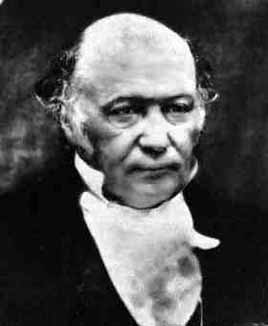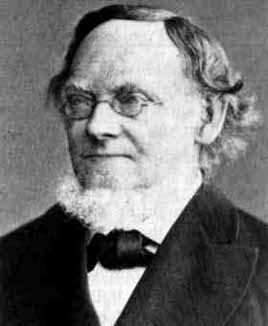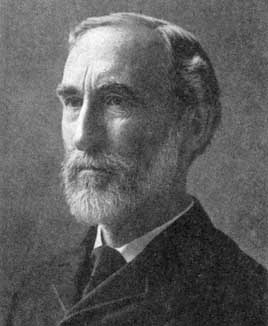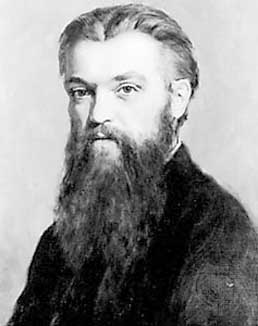Who was who in the history of Geometric Algebra?
 Sir
William Rowan Hamilton (1805-1865) His great mathematical intelligence
was awakened by the reading of Newton's Arithemtica universalis
when he was 12 years old. He went on to the Principia, and when
he was 17 attacked Laplace's Mécanique céleste. There he detected an error which was communicated to John Brinkley, then
royal astronomer in Ireland, who at once recognised one of the first mathematical
minds of the age. Hamilton had a brilliant career at the Trinity college,
Dublin, but before it was completed he was appointed, at the age of 22,
to the Andrews chair of astronomy in succession to Brinkley. The rest of
his life was spent at the observatory at Dunsik, near Dublin, in the close
study of mathematics. He married Hellen Mary Bayly in 1833. He was knighted
in 1835. At the time of his death, Sept. 2, 1865, Hamilton was working
on the Elements of Quaternions, on which the last six years of his
life had been spent.
Sir
William Rowan Hamilton (1805-1865) His great mathematical intelligence
was awakened by the reading of Newton's Arithemtica universalis
when he was 12 years old. He went on to the Principia, and when
he was 17 attacked Laplace's Mécanique céleste. There he detected an error which was communicated to John Brinkley, then
royal astronomer in Ireland, who at once recognised one of the first mathematical
minds of the age. Hamilton had a brilliant career at the Trinity college,
Dublin, but before it was completed he was appointed, at the age of 22,
to the Andrews chair of astronomy in succession to Brinkley. The rest of
his life was spent at the observatory at Dunsik, near Dublin, in the close
study of mathematics. He married Hellen Mary Bayly in 1833. He was knighted
in 1835. At the time of his death, Sept. 2, 1865, Hamilton was working
on the Elements of Quaternions, on which the last six years of his
life had been spent.
His earliest papers were the "Theory of Systems
of Rays" (Trans. Roy. Irish Acad., 1828-32); in the last of these,
by the aid of mathematics, he predicted conical refraction. These were
followed by papers on "The Principle of Varying Action" and in 1834 and
1835 by two memoirs "On a General Method in Dynamics". In these, Hamilton
defines the action as the path-integral of the Lagrangian function between
the initial and final states, so that the physical trajectory is, among
all the possible, that one which minimises the action integral, that is,
the path of least action. Then, he defines the generalised moments as the
partial derivatives of the Lagrangian function L with regard to the
velocities and obtains, through a Legendre transform of the Lagrangian
function, the H function, which depends on the generalised coordinates
and moments instead of the coordinates and velocities. The H function
(now called the Hamilton function) is usually the energy of the dynamical
system. The two physical revolutions of our finishing century, the Relativity
and Quantum theory, would not have been possible without Hamilton's
dynamics.
On Oct. 16, 1843, Hamilton discovered the quaternions
while he was walking with his wife along the Royal Canal, cutting with
a knife the fundamental formula on a stone of the Brougham Bridge:
i2 = j2
= k2 = i j k = -1
Hamilton's Lectures on Quaternions were published
in 1853 and his great book, The Elements of Quaternions, posthumously
in 1866. In the preface to the Lectures he describes the steps by
which he reached his important conclusions which form the germ of the later
basic theories of hypercomplex numbers.
He left an enormous collection of manuscript books,
full of original investigations, that were handed over to the Trinity
college.
 Hermann
Günther Grassmann (1809-1877) Born in Stettin (at that time a
Prussian town, today in Poland), he learned mathematics mainly from his
father Justus Günther Grassmann (1779-1852), teacher at the Stettin
Gymnasium. He taught science and mathematics at various schools at Stettin
despite his attempts to attain a university post. Grassmann is the key
man in the development of the geometric algebra. Initially thought and
proposed with the name of characteristica geometrica by Leibniz,
he could not see the realisation of his idea of a direct calculus of purely
geometric entities. In 1844 a prize (45 gold ducats for 1846) was offered
by the Fürstlich Jablonowski'schen Gessellschaft in Leipzig to whom
was capable to develop the idea of Leibniz. Grassmann won this prize with
the Geometric Analysis, published by this society in 1847 with a
foreword of August Ferdinand Möbius. Its content is essentially that
of Die Ausdehnungslehre (1844), where Grassmann defined the exterior
(or outer) product of two or more segments by means of successive parallel
transports. His formalism is the groundwork of the geometric algebra. Grassman
also worked in statics, dynamics and electromagnetism. He published the
Theorie
der Ebbe und Flut, the Lehrbuch der Arithmetik, influencing
Peano in his system of axioms, and Lehrbuch der Trigonometrie. The
scarce reception of the second edition of Die Ausdehnungslehre (1862)
caused him to dedicate himself mainly to philological studies. He composed
a dictionary of Sanskrit language and translated the Rig-Veda. The article
"Der Ort der Hamilton'schen Quaternionen in der Ausdehnungslehre"
plays main role in the history of the geometric algebra.
Hermann
Günther Grassmann (1809-1877) Born in Stettin (at that time a
Prussian town, today in Poland), he learned mathematics mainly from his
father Justus Günther Grassmann (1779-1852), teacher at the Stettin
Gymnasium. He taught science and mathematics at various schools at Stettin
despite his attempts to attain a university post. Grassmann is the key
man in the development of the geometric algebra. Initially thought and
proposed with the name of characteristica geometrica by Leibniz,
he could not see the realisation of his idea of a direct calculus of purely
geometric entities. In 1844 a prize (45 gold ducats for 1846) was offered
by the Fürstlich Jablonowski'schen Gessellschaft in Leipzig to whom
was capable to develop the idea of Leibniz. Grassmann won this prize with
the Geometric Analysis, published by this society in 1847 with a
foreword of August Ferdinand Möbius. Its content is essentially that
of Die Ausdehnungslehre (1844), where Grassmann defined the exterior
(or outer) product of two or more segments by means of successive parallel
transports. His formalism is the groundwork of the geometric algebra. Grassman
also worked in statics, dynamics and electromagnetism. He published the
Theorie
der Ebbe und Flut, the Lehrbuch der Arithmetik, influencing
Peano in his system of axioms, and Lehrbuch der Trigonometrie. The
scarce reception of the second edition of Die Ausdehnungslehre (1862)
caused him to dedicate himself mainly to philological studies. He composed
a dictionary of Sanskrit language and translated the Rig-Veda. The article
"Der Ort der Hamilton'schen Quaternionen in der Ausdehnungslehre"
plays main role in the history of the geometric algebra.
 Josiah
Willard Gibbs (1839-1903) Born in New Haven (U.S.A.) he graduated in
1858 and attained in 1863 the first doctorate in engineering given in the
United States. Then, he became tutor and taught Latin firstly and natural
philosophy afterwards at the Yale University until 1866. That year, he went
with his sisters to Europe where he spent three years. He studied in Berlin
with Magnus, Weierstrass and others and in Heidelberg with Kirchoff and
Helmholtz, but he did not visit the United Kingdom. With a good knowledge
of the German language, he was imbued by the German way of thinking, which
is reflected in all his writings. When he returned to New Haven in 1869,
he lived with the family of his sister Julia in the home built by his father
until his death. In 1871 Gibbs attained the recently created chair of mathematical
physics at Yale college.
Josiah
Willard Gibbs (1839-1903) Born in New Haven (U.S.A.) he graduated in
1858 and attained in 1863 the first doctorate in engineering given in the
United States. Then, he became tutor and taught Latin firstly and natural
philosophy afterwards at the Yale University until 1866. That year, he went
with his sisters to Europe where he spent three years. He studied in Berlin
with Magnus, Weierstrass and others and in Heidelberg with Kirchoff and
Helmholtz, but he did not visit the United Kingdom. With a good knowledge
of the German language, he was imbued by the German way of thinking, which
is reflected in all his writings. When he returned to New Haven in 1869,
he lived with the family of his sister Julia in the home built by his father
until his death. In 1871 Gibbs attained the recently created chair of mathematical
physics at Yale college.
Gibbs was a delayed scientific writer, who applied
very widely the mathematical tools to the description of the physical and
chemical phenomena. In 1876-78 he published On the Equilibrium of Heterogeneous
Substances, where he states the famous rule of phases giving the number
of independent thermodynamic magnitudes in a heterogeneous chemical system.
From the differential equation of energy, Gibbs defined mathematically
the chemical potential, a new thermodynamic magnitude which could not be
directly measured until the apparition of the modern electrodes. I think
that the history of thermodynamics has two periods, a first one before
Gibbs when the energy, entropy, and other magnitudes were discovered, and
a second one after and due to him when thermodynamics became an exact science.
From 1877 Gibbs taught electromagnetism and hence he printed privately
Elements
of Vector Analysis in 1881 and 1884 for the use of his students. He
also sent this "pamphlet" to important scientists, so that the
quaternionists,
whose leader was Peter Guthrie Tait, broke out an epistolary war in Nature.
The publication of the book Vector Analysis would wait until
1901. His last work, Elementary Principles in Statistical Mechanics
(1903) is a deep development of Boltzmann's statistical conception
of entropy. On the other hand, Gibbs was the first scientist who rigorously
deduced the capillary adsorption equation from thermodynamics.
Although he was not a mathematician, his mind was
of mathematical nature and exact meaning. His mathematical contributions
are the Gibbs
phenomenon of the Fourier series, a method of determination of an orbit
of a comet from only three observations and mainly the vector analysis,
which we teach in the same manner and notation that he used.
 William
Kingdon Clifford (1845-1879). Born in Exeter, he was educated at the
King's college, London, and at the Trinity college, Cambridge, where he was
elected fellow in 1868. He became professor of mathematics at the University
college, London, in 1871. In 1875 he married Lucy Lane, who became well
known as a novelist under her married surname. Clifford died prematurely
of pulmonary tuberculosis in Madeira. Clifford was simultaneously a philosopher
and a mathematician. His philosophic writings are as important as his mathematical
papers. He studied non-Euclidean geometry and the biquaternions. Due to
his short life, he wrote few but fundamental papers about the geometric algebra. In
"Applications of Grassmann's Extensive Algebra" (Am. J.
of Math. 1 [1878]) he showed the exact meaning and location
of quaternions inside Grassmann's Extension Theory, making the synthesis
of both systems which is known today as Clifford algebra. However, Gibbs
and Heaviside did not take notice of it. In 1876 Clifford fell ill and
he never recovered his health.
William
Kingdon Clifford (1845-1879). Born in Exeter, he was educated at the
King's college, London, and at the Trinity college, Cambridge, where he was
elected fellow in 1868. He became professor of mathematics at the University
college, London, in 1871. In 1875 he married Lucy Lane, who became well
known as a novelist under her married surname. Clifford died prematurely
of pulmonary tuberculosis in Madeira. Clifford was simultaneously a philosopher
and a mathematician. His philosophic writings are as important as his mathematical
papers. He studied non-Euclidean geometry and the biquaternions. Due to
his short life, he wrote few but fundamental papers about the geometric algebra. In
"Applications of Grassmann's Extensive Algebra" (Am. J.
of Math. 1 [1878]) he showed the exact meaning and location
of quaternions inside Grassmann's Extension Theory, making the synthesis
of both systems which is known today as Clifford algebra. However, Gibbs
and Heaviside did not take notice of it. In 1876 Clifford fell ill and
he never recovered his health.
 Sir
William Rowan Hamilton (1805-1865) His great mathematical intelligence
was awakened by the reading of Newton's Arithemtica universalis
when he was 12 years old. He went on to the Principia, and when
he was 17 attacked Laplace's Mécanique céleste. There he detected an error which was communicated to John Brinkley, then
royal astronomer in Ireland, who at once recognised one of the first mathematical
minds of the age. Hamilton had a brilliant career at the Trinity college,
Dublin, but before it was completed he was appointed, at the age of 22,
to the Andrews chair of astronomy in succession to Brinkley. The rest of
his life was spent at the observatory at Dunsik, near Dublin, in the close
study of mathematics. He married Hellen Mary Bayly in 1833. He was knighted
in 1835. At the time of his death, Sept. 2, 1865, Hamilton was working
on the Elements of Quaternions, on which the last six years of his
life had been spent.
Sir
William Rowan Hamilton (1805-1865) His great mathematical intelligence
was awakened by the reading of Newton's Arithemtica universalis
when he was 12 years old. He went on to the Principia, and when
he was 17 attacked Laplace's Mécanique céleste. There he detected an error which was communicated to John Brinkley, then
royal astronomer in Ireland, who at once recognised one of the first mathematical
minds of the age. Hamilton had a brilliant career at the Trinity college,
Dublin, but before it was completed he was appointed, at the age of 22,
to the Andrews chair of astronomy in succession to Brinkley. The rest of
his life was spent at the observatory at Dunsik, near Dublin, in the close
study of mathematics. He married Hellen Mary Bayly in 1833. He was knighted
in 1835. At the time of his death, Sept. 2, 1865, Hamilton was working
on the Elements of Quaternions, on which the last six years of his
life had been spent.


